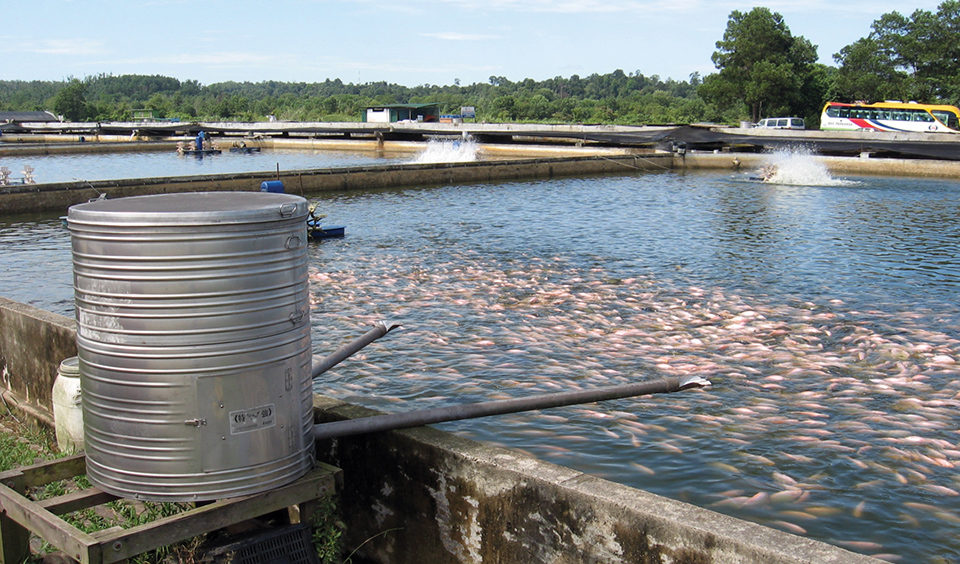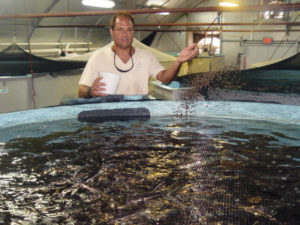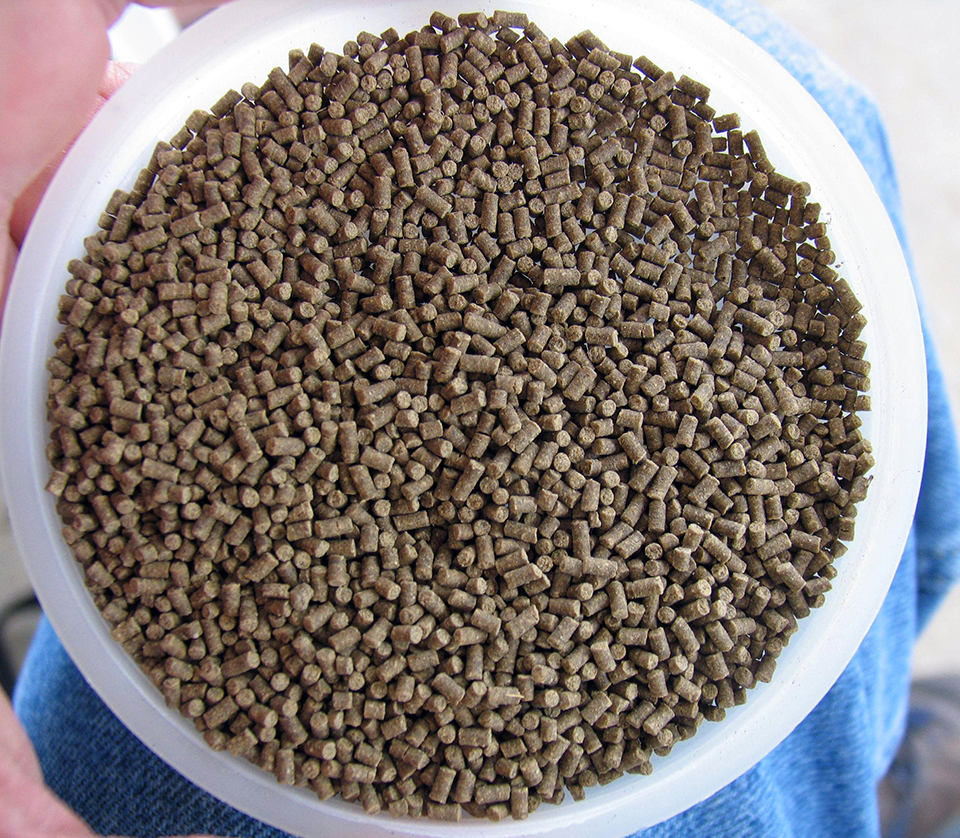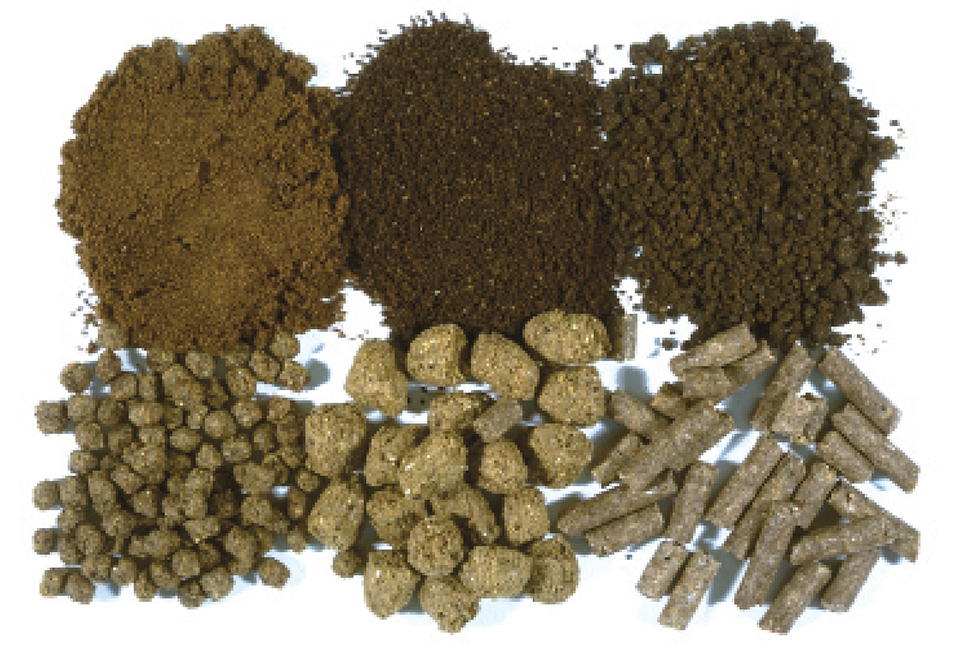Uniformity of growth an indicator of success

In addition to appropriate feed formulation targeted to the culture species and culture system, factors such as feeding method, production goals, andmarket demandsmust be considered in establishing optimal feeding strategies. Once in place, feeding strategies can be further tuned based on animal as well as environmental indicators to obtain maximized intake, growth, and efficiency.
Feeding methods
Fish and other farmed seafood species are either fed to satiation or receive a fixed ration, generally as a percentage of their body weight, which is dependent on animal size and species, and temperature. Both approaches have advantages and disadvantages. An important advantage of hand feeding is that farmers can observe feeding activity and changes in behavior. When feeding to satiation, trained and alert farmers minimize feed waste and maximize intake. Fixed feeding requires that farmers know the number and weight of fish in their systems, data that is obtained at stocking. This method requires periodic sampling of the stock and adjustments to the feeding rate. In systems where periodic sampling can’t be performed and adjustments aremade on estimated growth rates, or where it is hard to track mortalities, there is the potential for overfeeding or underfeeding.
If the estimated growth rate or number of remaining fish is too high, then overfeeding occurs and reduces feed efficiency and water quality. If the estimated growth rate or number of fish is too low, underfeeding results in smaller than anticipated fish and decreased profits.
Automated feeders
One determinant for choosing satiation or fixed rate feeding is the method by which fish are fed. If fish are fed by hand, either method can be effectively used. However, if they are fed with an automatic feeder, a fixed ration is preferred.
Automatic feeders can be programmed or loaded to apply a predetermined amount of feed at set times, which can reduce costs by saving time and labor. However, they can represent a degree of separation between farmers and their fish. Also, care must be taken to choose feeders that don’t break up the feed, causing fine particles that degrade water quality and waste money.
Demand feeders are another alternative for saving time and labor. They allow fish to self-feed by striking a trigger to release feed. Early demand feeders were notorious for stickingbopen and dropping all the feed, but newer models minimize this problem. A drawback with demand feeders is that not all fish tend are fed the same, as larger, more aggressive fish receive more feed. This leads to greater variation in fish size.
Production goals
Production goals are also important in developing appropriate feeding management strategies. If costs dictate short production cycles to increase throughput, as is often the case with recirculation, a strategy to maximize growth would be in order. However, if water quality is a concern and water availability is limited, or natural productivity is utilized, then a strategy to maximize efficiency may be more suitable.
If the stock is of high value – such as broodstock, ornamentals, or organically raised – a specialized diet with a regimented schedule might be most appropriate. Market demands and final product quality may dictate feed reduction or suspension to remove off-flavors, or specialized finishing, broodstock, or low-pollution diets. Production goals might dictate organic feeds for targeted market appeal, diets high in unsaturated fatty acids for human health benefits, or inclusion of vitamin E to improve shelf life.
Contingencies, storage

Successful feeding management also incorporates contingency plans for feeding during unexpected situations or emergencies such as power failures, loss of recirculation or aeration, low dissolved oxygen, high ammonia or nitrite levels, fish kills, signs of disease, or when stock needs to be held longer than anticipated. Contingency plans set critical points for suspending or reducing feeding, or even increasing feeding to obtain compensatory growth once problem are solved.
An often-overlooked consideration in feeding management is proper storage of feed. Feed should be stored in a cool, dry place, as damp feed degrades and molds quickly. Moldy feed is toxic to fish and should be discarded immediately. Store feeds where conditions do not exceed 22 degrees-C temperature or 75 percent humidity.
Feed should be handled with care to minimize pellet breakage, as the fine particles created represent wasted feed. Feed orders should be arranged to ensure all feed is used in less than 90 days. Old feed presents increased risks of vitamin degradation and rancidity.
Evaluating feeding strategy
The most obvious and most frequently used method for evaluating a feeding strategy is growth.When a successful strategy is employed, fish maintain the targeted growth rate to meet production goals. Uniformity of growth is another indicator. In theory, fish fed a diet that meets all their nutritional requirements at the proper rate and proper time reach their genetic potential and grow at similar rates. Constant growth can also be an effective indicator.
Mortality, can be used to evaluate feeding management as well. Well-balanced feeds reduce susceptibility to disease outbreaks by reducing stress and enhancing animals’ natural immune systems.
They also reduce the incidence of cannibalism in species that exhibit that behavior. Presenting balanced feed at the appropriate time and frequency also decreases fin nipping and aggressive behavior.
Health status is also an indicator of appropriate feeding. Observation of sick or weakly swimming fish, or intermittent disease outbreaks indicates that changes in feed management are needed.While clinical diagnoses are beyond the expertise and means of most farm managers, fish can also be examined externally for signs of nutrient deficiencies or toxicity.
Water quality status is another useful reference. Overfeeding or feeding poor-quality diets can deteriorate water quality. Difficulties maintaining suitable ammonia or nitrite levels can indicate too-frequent feeding or feed with inferior protein ingredients, overly high protein content, or low energy content. High levels of solids or problemswith lowdissolved oxygen can indicate feed with poorly digested ingredients that can increase organic loads.
Another easy way to evaluate feeding management is to monitor both animal and farm efficiency. Whereas overfeeding decreases water quality, underfeeding causes less than anticipated growth and longer time to market, resulting in increased costs and decreased farm efficiency. Since maximal fish growth occurs when energy supplied by fats and carbohydrates is appropriate and amino acids are consumed in the right balance at the right time, a decrease in efficiency may require a reevaluation of the overall feeding management strategy.
(Editor’s Note: This article was originally published in the January/February 2008 print edition of the Global Aquaculture Advocate.)
Now that you've reached the end of the article ...
… please consider supporting GSA’s mission to advance responsible seafood practices through education, advocacy and third-party assurances. The Advocate aims to document the evolution of responsible seafood practices and share the expansive knowledge of our vast network of contributors.
By becoming a Global Seafood Alliance member, you’re ensuring that all of the pre-competitive work we do through member benefits, resources and events can continue. Individual membership costs just $50 a year.
Not a GSA member? Join us.
Author
-
Marty Riche, Ph.D.
United States Department of Agriculture
Agricultural Research Service
Harbor Branch Oceanographic Institute
5600 U.S. Highway 1 North
Fort Pierce, Florida 34946 USA
Tagged With
Related Posts

Health & Welfare
10 paths to low productivity and profitability with tilapia in sub-Saharan Africa
Tilapia culture in sub-Saharan Africa suffers from low productivity and profitability. A comprehensive management approach is needed to address the root causes.

Health & Welfare
A case for better shrimp nutrition
Shrimp farm performance can often be below realistic production standards. Use proven nutrition, feeds and feeding techniques to improve profitability.

Responsibility
A look at integrated multi-trophic aquaculture
In integrated multi-trophic aquaculture, farmers combine the cultivation of fed species such as finfish or shrimp with extractive seaweeds, aquatic plants and shellfish and other invertebrates that recapture organic and inorganic particulate nutrients for their growth.

Aquafeeds
Food for thought: Feed management strategies, part 1
Based on thorough knowledge of the culture species, feed formulations must deliver protein and energy, and a balance of nutrients in a palatable form consumed with little waste.



